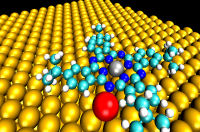Collaborating with the Chinese Academy of Sciences in Beijing, scientists from the University of Liverpool in England studied the rotation of ferrules anchored to a fixed surface to test their ability to be used in the development of future moving and rotating nanomachines.

Collaborating with the Chinese Academy of Sciences in Beijing, scientists from the University of Liverpool in England studied the rotation of ferrules anchored to a fixed surface to test their ability to be used in the development of future moving and rotating nanomachines.
The research focused on receiving magnetic fields, which play an important role in machines such as electric motors and generators. The limitation of atomic level technology is in replicating this feature with rotors the size of small frogs. A number of rotating coils have already been identified, but so far no such coils have been used to induce rotating magnetic fields.
The researchers used a gold surface to anchor to it phthalocyanine beads (Wikipedia entry), which have a metallic center, in an extensive structure. The anchoring point, a single gold atom located on the gold surface and bound to a nitrogen atom of the large ferrode, allowed the ferrodes to circle, with a small offset from their center.
Professor Werner Hofer, from the University's School of Chemistry, explains: "The difficulty in making molecular rotors lies in the fact that the particles are required for a fixed anchoring point and they will usually build up with the surface to which they are attached. A gold surface reacts weakly with ferrode; Moreover, it provides regular anchoring points for tying single strands, which then arrange themselves in regular and extensive arrays."
"The central atoms, which are metallic, revolve around the gold atoms and thereby create a rotation with a small offset from their center. The advantage of phthalocyanines lies in the fact that their center can contain any metal atom; The research could in the next step lead to the development of rotating magnetic fields on a very tiny scale."
Scientists believe that studies such as these could be the first steps in the production of machinery used to produce currents on a small scale.
The article was published in the scientific journal Physical Review letters.
